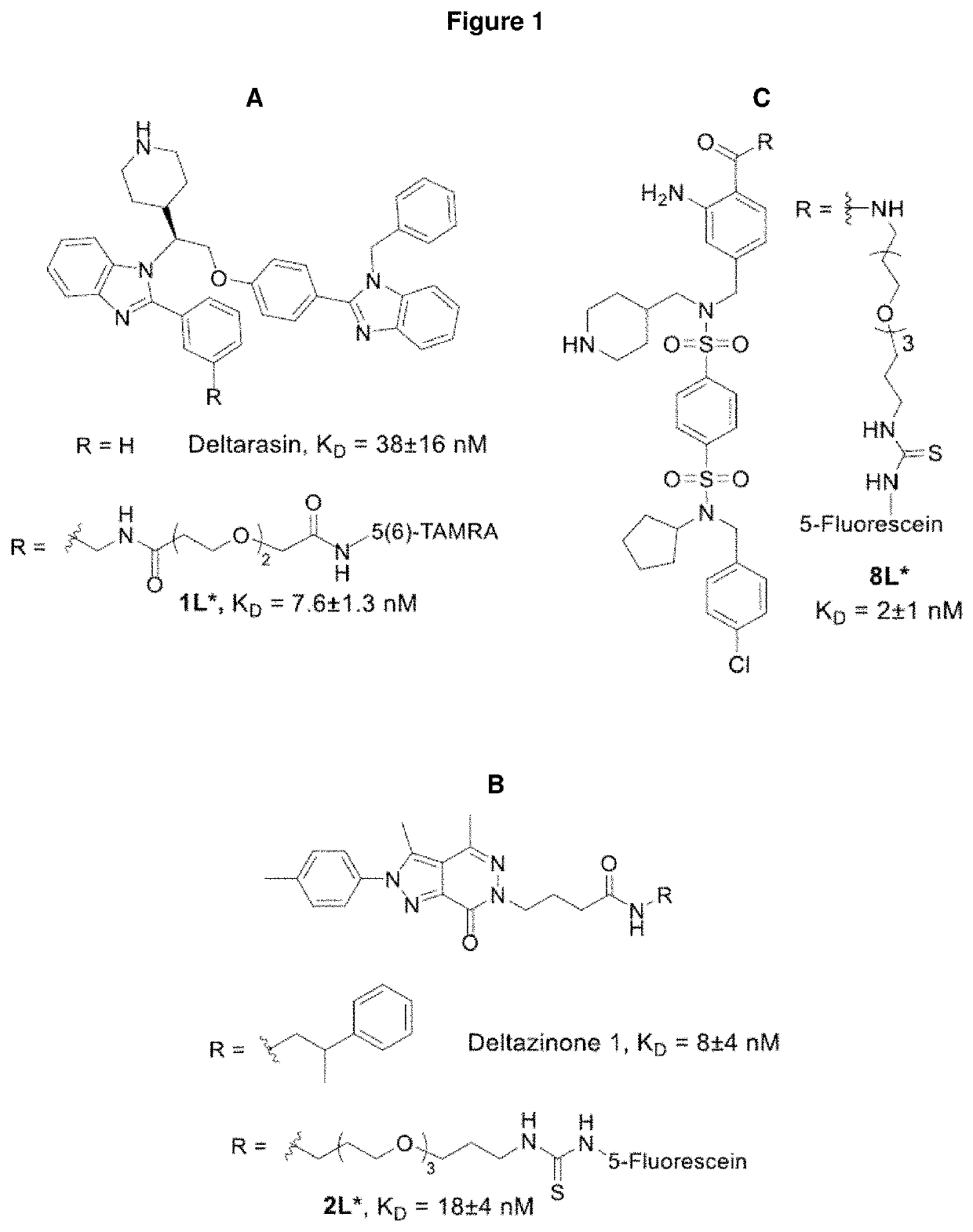Benzene disulfonamide for the treatment of cancer
a technology of benzene disulfonamide and cancer, applied in the field of benzene disulfonamide for the treatment of cancer, can solve the problems of preventing efficient release, accumulating ras, and no clinically useful drug found
- Summary
- Abstract
- Description
- Claims
- Application Information
AI Technical Summary
Benefits of technology
Problems solved by technology
Method used
Image
Examples
examples
[0376]A. Chemical Synthesis
[0377]General Information:
[0378]All reactions involving air- or moisture-sensitive reagents or intermediates were carried out in flame dried glassware under an argon atmosphere. Dry solvents (THF, toluene, MeOH, DMF) were used as commercially available; CH2Cl2 was purified by the Solvent Purification System M-BRAUN Glovebox Technology SPS-800. Analytical thin-layer chromatography (TLC) was performed on Merck silica gel aluminium plates with F-254 indicator. Compounds were visualized by irradiation with UV light or potassium permanganate staining. Column chromatography was performed using silica gel Merck 60 (particle size 0.040-0.063 mm). 1H-NMR and 13C-NMR were recorded on a Bruker DRX400 (400 MHz), Bruker DRX500 (500 MHz), INOVA500 (500 MHz) and DRX600 (600 MHz) at 300 K using CDCl3, CD3OD or (CD3)2SO as solvents. All resonances are reported relative to TMS. Spectra were calibrated relative to solvent's residual proton and carbon chemical shift: CDCl3 (δ...
example a-01
of N-(4-chlorobenzyl)cyclopentanamine, 8*
[0384]
[0385]The title compound (11.7 g, 93% yield) was prepared according to the KY reductive amination procedure I by using 4-chlorobenzaldehyde (10.0 g, 71.4 mmol), cyclopentylamine (7.5 mL, 71.4 mmol), MgSO4 (26.20 g, 214 mmol) and NaBH4 (1.35 g, 37.7 mmol. 1H NMR (400 MHz, CDCl3) δ 7.26 (m, 4H, 4 CH, Ar), 3.72 (s, 2H, CH2-ArCl), 3.08 (q, J=7 Hz, 1H, CH, Cp), 1.83 (m, 2H), 1.69 (m, 2H), 1.53 (m, 2H), 1.34 (m, 2H). 13C NMR (101 MHz, CDCl3) δ 139.4 (C), 132.6 (C), 129.6 (2 CH, Ar), 128.6 (2 CH, Ar), 59.3 (CH, Cp), 52.1 (CH2-ArCl), 33.3 (2 CH2), 24.2 (2 CH2). HRMS: calc. for [M+H]+ C12H17ClN: 210.0971, found: 210.1044.
example a-02
of 4-bromo-N-(4-chlorobenzyl)-N-cyclopentylbenzenesulfonamide, 9*
[0386]
[0387]A solution of 4-bromobenzenesulfonyl chloride (3.5 g, 13.7 mmol) and N-(4-chlorobenzyl)cyclopentanamine (2.87 g, 13.7 mmol) in dichloromethane (18 mL / mmol) was treated with triethylamine (2.7 mL, 20.6 mmol) and stirred at room temperature for 5 h. Water was then added to the mixture and the solution was extracted with dichloromethane. The combined organic phases were washed with brine dried over magnesium sulfate, filtered and concentrated under vacuum. The crude product was purified by flash column chromatography on silica gel using 20% ethylacetate / cyclohexane as an eluent to provide analytically pure product (4.49 g, 76% yield). 1H NMR (400 MHz, cdcl3) δ 7.64 (m, 4H, 4 CH, Ar), 7.30 (m, 4H, 4 CH, Ar), 4.31 (s, 2H, CH2-ArCl), 4.25 (dd, J=17, 9 Hz, 1H, CH, Cp), 1.61 (m, 2H), 1.51 (m, 2H), 1.42 (m, 2H), 1.25 (m, 2H). 13C NMR (101 MHz, cdcl3) δ 139.8 (C), 137.4 (C), 133.2 (C), 132.5 (2 CH, Ar), 128.8 (2 CH, ...
PUM
| Property | Measurement | Unit |
|---|---|---|
| melting temperature | aaaaa | aaaaa |
| particle size | aaaaa | aaaaa |
| particle size | aaaaa | aaaaa |
Abstract
Description
Claims
Application Information
 Login to View More
Login to View More - R&D
- Intellectual Property
- Life Sciences
- Materials
- Tech Scout
- Unparalleled Data Quality
- Higher Quality Content
- 60% Fewer Hallucinations
Browse by: Latest US Patents, China's latest patents, Technical Efficacy Thesaurus, Application Domain, Technology Topic, Popular Technical Reports.
© 2025 PatSnap. All rights reserved.Legal|Privacy policy|Modern Slavery Act Transparency Statement|Sitemap|About US| Contact US: help@patsnap.com



